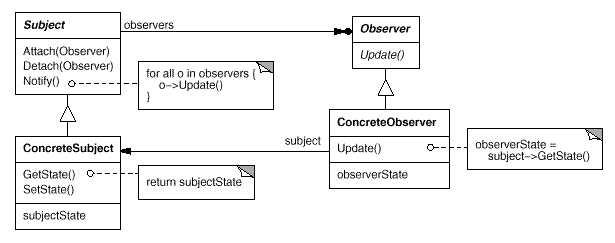- Aka: Dependents. Publish-Subscribe
- Intent: Define a one-to-many dependency between objects so that when one object changes state, all its dependents are notified and updated automatically.
Structure §

Image from: Gamma, Helm, Johnson, and Vissides
Applicability §
- When an abstraction has two key aspects: one dependent on the other.
- When a change to one object requires changing others and you don’t know how many objects need to be changed.
- When an object should be able to notify other objects without making assumptions about who these objects are.
Consequences §
- Lets you vary subjects and their observers independently.
- Abstract coupling between subject and object
- Support for broadcast communication.
- Freedom for adding and removing observers
- Observers can be blind to the cost of updates
Implementation §
Subject-Observer Mapping §
- Use associative look up (Hash tables tables) if space is an issue
- Store references to observers in the subject if time is an issue
Multiple subjects §
- If more than one subject is to be observed, the observer should know which subject is changing. Achieved by passing subject as parameter for update.
Update Triggers §
- Have state-setting operations on subject notify all observers (client doesn’t need to remember to notify observers, but consecutive operations may be inefficient)
- Make clients responsible for calling Notify at the right time (avoids unnecessary intermediate updates at the cost of the client having the responsibility to notify observers)
Handling Dangling Subject References §
- Make subject notify observers as it is deleted
Ensuring State Invariance §
- Send notifications from a template method
Avoid observer specific update protocols §
- Push-model – subject sends observers detailed information about the change (makes code less reusable due to assumptions that may not be true).
- Pull model – the subject sends nothing but the most minimal notification and observers ask for details (inefficient)
Update Efficiency §
- Improve update efficiency by specifying modifications of interest explicitly.
- Use a change manager (Singleton and Mediator) for complex update semantics to minimize the work required to update observers.. The change manager is responsible for:
- Mapping subject to observers
- Define update strategies
- Updates all observers upon request.
